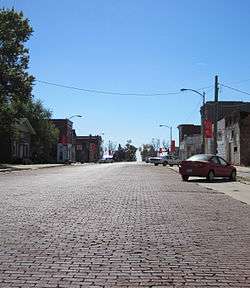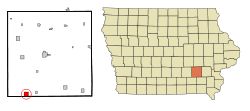Hedrick, Iowa
| Hedrick, Iowa | |
|---|---|
| City | |
 | |
| Motto(s): "Where Friends Meet"[1] | |
 Location of Hedrick, Iowa | |
| Coordinates: 41°10′25″N 92°18′30″W / 41.17361°N 92.30833°WCoordinates: 41°10′25″N 92°18′30″W / 41.17361°N 92.30833°W | |
| Country |
|
| State |
|
| County | Keokuk |
| Area[2] | |
| • Total | 1.53 sq mi (3.96 km2) |
| • Land | 1.53 sq mi (3.96 km2) |
| • Water | 0 sq mi (0 km2) |
| Elevation | 820 ft (250 m) |
| Population (2010)[3] | |
| • Total | 764 |
| • Estimate (2016)[4] | 740 |
| • Density | 499/sq mi (192.8/km2) |
| Time zone | UTC-6 (Central (CST)) |
| • Summer (DST) | UTC-5 (CDT) |
| ZIP code | 52563 |
| Area code(s) | 641 |
| FIPS code | 19-35670 |
| GNIS feature ID | 0457375 |
| Website | Hedrick, Iowa |
Hedrick is a city in Keokuk County, Iowa, United States. The population was 764 at the 2010 census.
History
Hedrick was incorporated on April 23, 1883.[5] It was named for General Hedrick.[6]
By 1991 several businesses in the community's main street closed, and the economy had declined. The school serving the town closed that year.[7]
Geography
Hedrick is located at 41°10′25″N 92°18′30″W / 41.17361°N 92.30833°W (41.173733, -92.308294).[8]
According to the United States Census Bureau, the city has a total area of 1.53 square miles (3.96 km2), all of it land.[2]
Demographics
| Historical populations | ||
|---|---|---|
| Year | Pop. | ±% |
| 1890 | 592 | — |
| 1900 | 1,035 | +74.8% |
| 1910 | 978 | −5.5% |
| 1920 | 901 | −7.9% |
| 1930 | 810 | −10.1% |
| 1940 | 731 | −9.8% |
| 1950 | 733 | +0.3% |
| 1960 | 762 | +4.0% |
| 1970 | 790 | +3.7% |
| 1980 | 847 | +7.2% |
| 1990 | 810 | −4.4% |
| 2000 | 837 | +3.3% |
| 2010 | 764 | −8.7% |
| 2016 | 740 | −3.1% |
| Source:"American FactFinder". United States Census Bureau.
and Iowa Data Center Source: | ||
2010 census
As of the census[3] of 2010, there were 764 people, 310 households, and 211 families residing in the city. The population density was 499.3 inhabitants per square mile (192.8/km2). There were 356 housing units at an average density of 232.7 per square mile (89.8/km2). The racial makeup of the city was 98.3% White, 1.2% African American, and 0.5% from two or more races. Hispanic or Latino of any race were 1.4% of the population.
There were 310 households of which 31.9% had children under the age of 18 living with them, 51.3% were married couples living together, 11.0% had a female householder with no husband present, 5.8% had a male householder with no wife present, and 31.9% were non-families. 28.4% of all households were made up of individuals and 15.8% had someone living alone who was 65 years of age or older. The average household size was 2.46 and the average family size was 2.98.
The median age in the city was 37.7 years. 24.5% of residents were under the age of 18; 10% were between the ages of 18 and 24; 24.3% were from 25 to 44; 24.9% were from 45 to 64; and 16.4% were 65 years of age or older. The gender makeup of the city was 48.3% male and 51.7% female.
2000 census
As of the census[10] of 2000, there were 832 people, 335 households, and 233 families residing in the city. The population density was 543.1 people per square mile (209.8/km²). There were 371 housing units at an average density of 240.7 per square mile (93.0/km²). The racial makeup of the city was 98.92% White, 0.12% Native American, 0.12% from other races, and 0.84% from two or more races. Hispanic or Latino of any race were 0.84% of the population.
There were 335 households out of which 32.8% had children under the age of 18 living with them, 56.4% were married couples living together, 9.0% had a female householder with no husband present, and 30.4% were non-families. 28.1% of all households were made up of individuals and 17.6% had someone living alone who was 65 years of age or older. The average household size was 2.50 and the average family size was 3.04.
In the city, the population was spread out with 27.7% under the age of 18, 7.8% from 18 to 24, 26.3% from 25 to 44, 20.2% from 45 to 64, and 18.0% who were 65 years of age or older. The median age was 37 years. For every 100 females, there were 92.0 males. For every 100 females age 18 and over, there were 85.0 males.
The median income for a household in the city was $30,714, and the median income for a family was $37,917. Males had a median income of $30,000 versus $20,476 for females. The per capita income for the city was $14,166. About 9.0% of families and 13.5% of the population were below the poverty line, including 16.4% of those under age 18 and 10.8% of those age 65 or over.
Economy
Few businesses are open in the old historic business district; most businesses open to the public are located along Highway 149.
Arts and culture
Hedrick is notable for its well-preserved brick Main Street and its depot.
Education
Hedrick is in the Pekin Community School District,[11] which operates schools in Pekin.
The Hedrick school district closed in 1990 due to not meeting state requirements to be a certified school in the state of Iowa,[12] making it the first school district in the state to be closed involuntarily by the state government.[13] Students were rezoned to Pekin schools.[7]
References
- ↑ "Hedrick, Iowa". Hedrick, Iowa. Retrieved August 31, 2012.
- 1 2 "US Gazetteer files 2010". United States Census Bureau. Archived from the original on 2012-01-24. Retrieved 2012-05-11.
- 1 2 "American FactFinder". United States Census Bureau. Retrieved 2012-05-11.
- ↑ "Population and Housing Unit Estimates". Retrieved June 9, 2017.
- ↑ "Hedrick, Iowa". City-data.com. Retrieved August 31, 2012.
- ↑ Gannett, Henry (1905). The Origin of Certain Place Names in the United States. Govt. Print. Off. p. 153.
- 1 2 Vobejda, Barbara (1991-03-25). "MAIN STREET FACES 'ECONOMIC TRIAGE'". Washington Post. Retrieved 2018-06-19.
- ↑ "US Gazetteer files: 2010, 2000, and 1990". United States Census Bureau. 2011-02-12. Retrieved 2011-04-23.
- ↑ "Census of Population and Housing". Census.gov. Archived from the original on May 12, 2015. Retrieved June 4, 2015.
- ↑ "American FactFinder". United States Census Bureau. Retrieved 2008-01-31.
- ↑ "PEKIN." Iowa Department of Education. Retrieved on June 18, 2018.
- ↑ "Teacher Layoffs and School Budget Cuts" (PDF). National Education Association. Retrieved August 31, 2012.
- ↑ "More financial questions raised over closed Russell School District". Radio Iowa. 2009-09-08. Retrieved 2017-01-09.